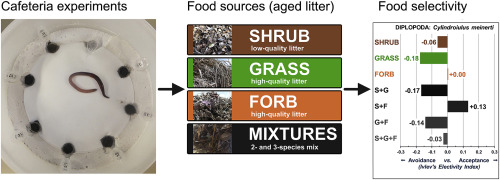Soil Biology and Biochemistry ( IF 9.8 ) Pub Date : 2020-03-18 , DOI: 10.1016/j.soilbio.2020.107786 Michael Steinwandter , Julia Seeber

|
Alpine semi-natural grasslands were formed by hundreds of years of traditional and extensive land-use resulting in a distinct flora and fauna. Socio-economic changes in the last century led to the abandonment of a large number of alpine pasturelands. Even though litter composition and quality will permanently alter due to shifts in plant species composition, consequences of abandonment and the subsequent shrub encroachment on the feeding activities of decomposers are not well known.
We conducted cafeteria feeding experiments in microcosms in a climate chamber with four abundant alpine decomposer species (two earthworms and two millipedes), offering them three representative alpine litter types (dwarf shrub, grass, and forb) as single litters and mixtures.
The epi-endogeic earthworm Lumbricus rubellus (Hoffmeister, 1843), dominant in alpine pastureland, had highest mean consumption rates (34.7 ± 24.7 mg), while Dendrobaena octaedra (Savigny, 1826), a strictly epigeic earthworm, showed considerably lower consumption rates. Millipedes showed similar consumption patterns, with Cylindroiulus fulviceps (Latzel, 1884) being less active than C. meinerti (Verhoeff, 1891). We found several cases where litter mixtures were preferred over single litters, including higher consumption rates of low-quality dwarf shrub litter by D. octaedra and C. meinerti when mixed with high-quality litter.
The tested specimens showed a high intra- and interspecific variability as they fed on all offered litter types and qualities, resulting in few specific food preferences and selections. We conclude that alpine soil macro-decomposer such as earthworms and millipedes are generalists feeding on a wide range of litter qualities, allowing them, in theory, to better adapt to the litter resources that become available when pastures are abandoned and reverted to shrubland.
中文翻译:

自助餐开放:在微观自助餐厅实验中,高山土壤宏分解物以各种各样的垫料为食
高山半自然草原由数百年的传统和广泛土地利用形成,形成了独特的动植物群。上个世纪的社会经济变化导致大量高山牧场的放弃。尽管凋落物的组成和质量会因植物物种组成的变化而永久改变,但弃草的后果以及随后的灌木侵蚀对分解动物的摄食活动的影响尚不清楚。
我们在气候室的缩影中进行了食堂喂养实验,该室有四种丰富的高山分解物(两种earth和两种千足虫),为它们提供了三种代表性的高山凋落物类型(矮灌木,草和草)作为单一凋落物和混合物。
在高寒牧场中占优势的表内地earth Lumbricus rubellus(Hoffmeister,1843)具有最高的平均食用率(34.7±24.7 mg),而严格上地ge的Dendrobaena octaedra(Savigny,1826)显示出较低的食用率。千足虫表现出相似的消费模式,富勒圆柱体(Latzel,1884年)的活性不如美因杯(C. meinerti)(Verhoeff,1891年)。我们发现在几种情况下,混合垫料比单面垫料更可取,包括D. octaedra和C. meinerti在与高质量垫料混合时提高了低质量矮矮灌木垫料的消耗率。
测试的标本在饲喂所有提供的垫料类型和品质时显示出较高的种内和种间变异性,因此很少有特定的食物偏爱和选择。我们得出的结论是,诸如soil和千足虫这样的高山土壤宏观分解者具有广泛的垫料品质,因此从理论上讲,它们可以更好地适应牧场被抛弃并恢复为灌木丛时可得到的垫料资源。











































 京公网安备 11010802027423号
京公网安备 11010802027423号